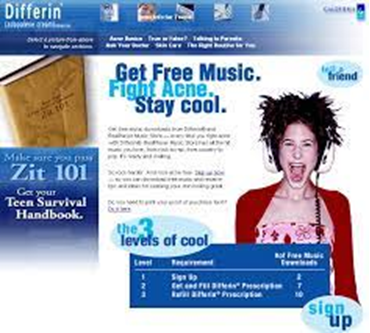Introduction
The availability of false and misleading drug advertisements causes serious harm to consumers and the healthcare system. Through research, most pharmaceutical advertisements are misleading and often aired on television and a cross-section of the internet. Direct-to-consumer advertising, especially for the pharmaceutical industry, refers to advertising and marketing of the drugs and medical services directly to the consumers who are the patients. Through major guidelines laid by the Food and Drug Administration, some rules and policies ought to be observed when making direct consumer advertisements which are highly disregarded. Good advertisement the consumers ought to empower and educate them consumers as well as
Figure 1; Description
The image provides a direct consumer pharmaceutical advertisement for teenagers to obtain a Teen Survival Handbook to take a self-care test on acne. This is one of the most outstanding advertisements that are made both on the internet and on television. The advert is directed to the youth as it uses some enticement of getting free music in return. This presents one of the adverts that play with the customers’ fears and gives birth to notions of the youths who need to feel empowered. The advert also has a hidden agenda; on the side, it is noted that parents are given talks regarding acne. This is with the realization that most of the teenagers will have to be accompanied by their parents. There is also incitement for the teenagers to talk to their parents to have them visit the physicians with various benefits highlighted. As per Gilbody et al. (2005), the teenagers will get to secure a prescription for Differin, which will earn them three astonishing levels in the subscription, including signing up for free music downloads, they get to have a fill of the Differin prescription, and they stand to have up to seven music downloads. Also, with more drug refills, teenagers can have more than ten downloads.
The image has bright colors that give it a smooth and soft texture. The texture makes the image feel livelier and well-executed. The virtual pattern of the image is nonrepetitive but inviting for youths as the image used to lure their attention is well presented. The image tells more of an affordable, accessible, and empowering piece of information but is done in the wrong manner. The image screams for attention, with most of the writings capturing the contrast of the image to reveal the intention.
As per Henry (2003), direct consumer pharmaceutical advertisement is illegal as it entices teenagers to convince their parents to purchase the drugs in return for having the benefits. This confirms the dangers that advertisements pose to the consumer. The advertisement has a high chance of misinforming the patients of what they are likely being administered. This danger may lead to over or under-treatment risks for the patients. The post also has a high probability of promoting much use of over-the-counter medicines with fewer teats which may affect many people’s health and lifestyle. Inappropriate prescribing is a crime under the Food and Drugs Authority.
Figure 2. Description
The image is that of a pharmaceutical advertisement that is done to promote cocaine as a toothache solution. The advert is brought out as an anesthetic. The image’s background is from a 19th-century advertisement to promote a cure for an aching tooth. Many of the drugs used then were manufactured with the ingredient, including proprietary cocaine, especially those concoctions meant for adults and older people. The image has various balanced works of art elements to show a good advertisement description. The colors adopted for the advert are thoroughly dull to showcase the advert was done sometime back. However, the image’s tone and texture are bright with some spatial variation with rather maximum pixels applied for the image. The texture is seen as that which is smooth and glossy.
The image presents cocaine as a potential aesthetic of toothache—the image from Grafton’s Street’s Dental Supply Company. According to Bells et al. (1999), this is a surprising advert given that the use of cocaine causes potential harm, and the British Medical Association flagged it as a medical hazard. From the analysis, the presumed drug cocaine causes true intoxication mania, which has been used to make chloral, opium, alcohol, and chloroform. With the decreased prices and alluring quick reaction, the patients would be convinced to purchase the cocaine. This is a danger causing dangerous compound and a compound of death when not regulated. This form of advert is dangerous to the people using it and others. Other recommended safe powders are for taking care of and healing a painful toothache.
Conclusion
From the analysis, the use of pharmaceutical advertisements poses’ great danger to patients and consumers. The advertisements have been designed to deliver the wrong message to the patient. Rather than focusing on ways to ensure that the drugs are well prescribed and taken, the pharmaceutical department also ensures that the medicine prescribed has the right ingredients and the suitable patients have access to it. In addition, using third parties to lure buyers is against the Food and Drug Administration.
References
Bell RA, Kravitz RL, Wilkes MS. Direct-to-consumer prescription drug advertising and the public. Journal of General Internal Medicine 1999; 14:651-7.
Gilbody S, Wilson P, Watt I. Benefits and harms of direct-to-consumer advertising: a systematic review. Quality & Safety in Health Care 2005; 14:246-50.
Henry J. Kaiser Family Foundation. Impact of direct-to-consumer advertising on prescription drug spending. June 2003. Available at: http://www.kff.org/rxdrugs/6084-index.cfm.
APPENDIX

Figure 1:Bell RA, Kravitz RL, Wilkes MS. Direct-to-consumer prescription drug advertising and the public. Journal of General Internal Medicine 1999; 14:651-7.

Figure 2: National Library of Medicine-History of Medicine
 write
write